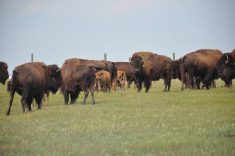It may never happen, but after years of losses, cattle producers are actually talking about supply management, said Scott McKinnon, a market analyst with Canfax.
“Never say never. I think producers are to the point where maybe that’s an option,” said McKinnon, during a media scrum following his presentation on the cattle market outlook at Ag Days in Brandon last week.
“I’m hearing talk about it but the further west you go, the more redneck we appear. They (producers) just want to manage their own affairs and go bankrupt on their own, I guess.”
Read Also

Trump’s tariffs take their toll on U.S. producers
U.S. farmers say Trump’s tariffs have been devastating for growers in that country.
Supply management is now part of the conversation because Canadian cattle producers have suffered through a long period of false hope, McKinnon added.
“We’ve been telling them, ‘one more year’ for 14 years,” he said, explaining that producers are always told that things will get better next year.
McKinnon told a large crowd that cattle market conditions should improve by the end of 2010.
“I think we will see it (profitability) late fall, potentially in the cow-calf sector,” he said.
Things may get better because the beef cow herd in Canada is contracting. It was more than 4.5 million head as of Jan. 1, 2009. When Statistics Canada numbers come out in February, Canfax expects it will fall to about 4.3 million.
McKinnon expects the downward trend to continue this year.
“We’re still in a retraction mode … I think we can see a continued three percent decline (in 2010).”
Jay Fox, president of the Manitoba Cattle Producers Association, also noted the shrinking cow herd.
“We’ve got the numbers going in our direction. The North American herd, the world herd as far as that’s concerned, is reducing.”
Regarding the talk of supply management, he thinks it’s idle chatter.
“There is discussion on it, but it all ends up at the end of the day … (if it comes to) 80 percent of the cattle producers leaving the industry, almost 100 percent of them are in disagreement with that,” he said, noting that supply management would force the vast majority of cattle producers out of the business.
While the smaller herd may boost prices, the demand side of the equation remains weak, McKinnon said.
“The kingpin … in 2010 is going to be demand and that’s a tough one to stimulate. Until we see economic recovery, that’s going to be the challenge,” he said, noting that more consumers are choosing to dine at home rather than eat steak at a restaurant.
Beef also faces tough competition from pork, McKinnon said.
“It doesn’t take much to see the impact that pork has when you go to the grocery story… You can buy pork loins as big as my head, and I’ve got a pretty big head, for $11 to $12,” he noted.
“I read an interesting stat the other day on the American pork herd, where the pork inventories in the U.S. are actually down 2.4 percent. But 2010 is still going to be the second largest hog inventory in recent history. So we’re not going to get a lot of relief from the pork in the near future.”
But McKinnon said there is hope on the demand side because consumer psychology is an important component of a recession.
“We have high unemployment rates in the U.S., well over 10 percent now…. But I think it’s more a state of mind. The money is out there, I think they just have to be convinced that the recession is improving.”
McKinnon said prices looked promising in the spring.
“I have a nickname for this slide. … I call it the barbecue season that never came,” he noted, pointing to a chart showing the Alberta weekly fed steer price hit $100 per cwt in March.
“That’s when we ran out of yearlings,” he said, gesturing to the peak.
But following that peak, cool weather had a chilling effect on the market. By the summer of 2009, prices slid below $85 per cwt.















